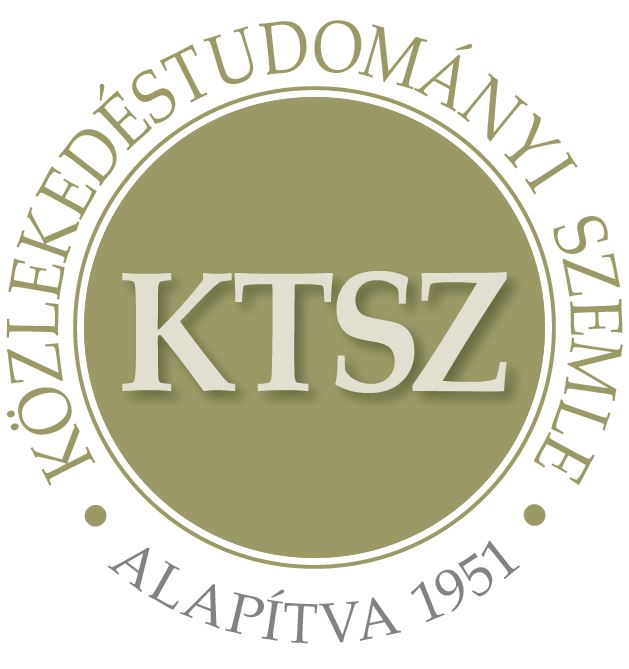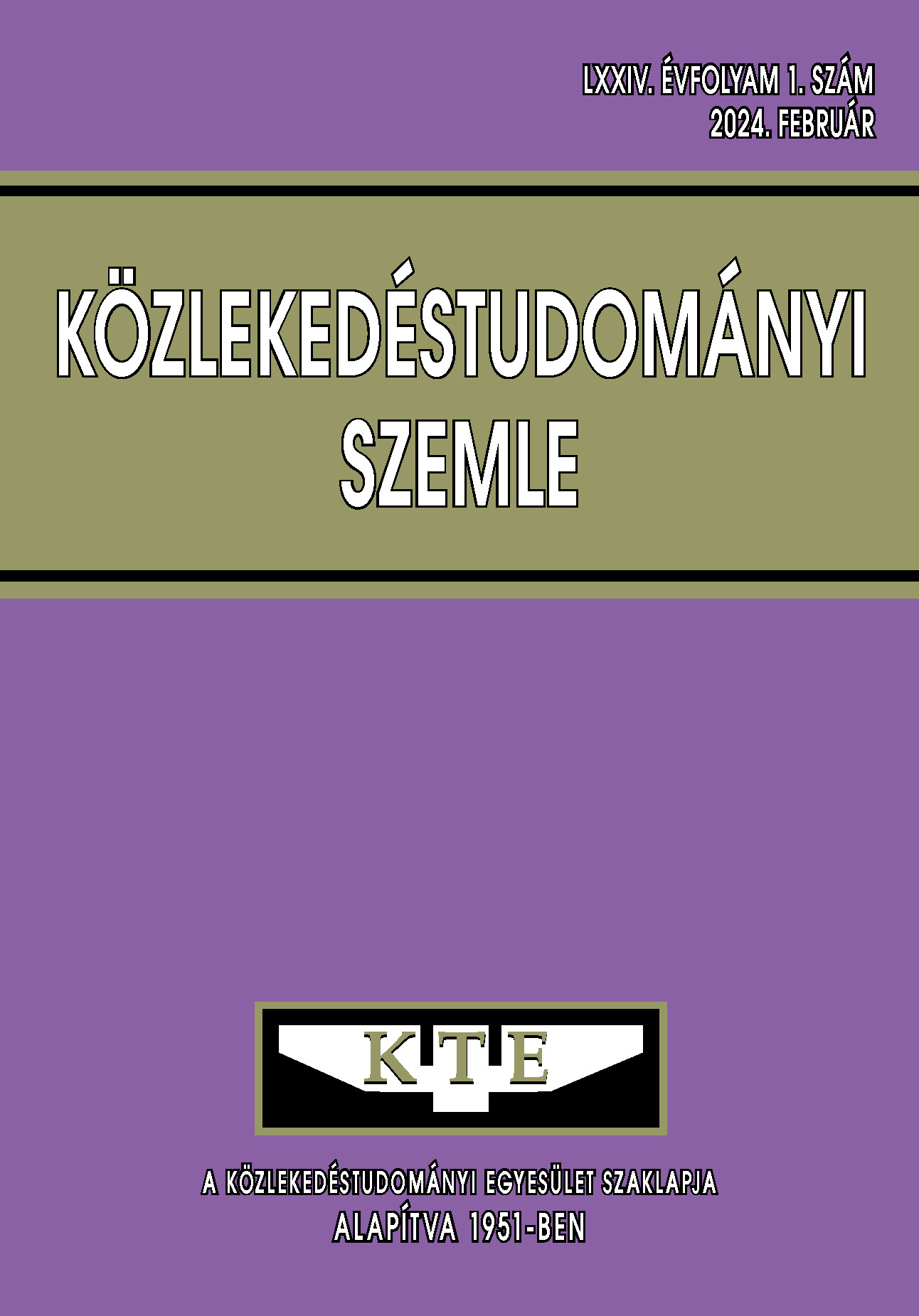Optimizing airport stand allocation using multi objective linear programming
Abstract
Airport stand allocation is a multi-purpose optimization process that has an impact on operational efficiency and requires rapid intervention in case of changing conditions (e.g., managing delays in case of severe weather conditions), especially at busy airports. In our article, we model and optimize airport stand allocation, which is the scientific value. We
present the process and the problem of airport stand allocation, with a special focus on factors influencing the allocation. We develop a linear programming model of stand allocation, define constraints and objective functions considering parking (stand usage) cost and passenger walking time among others. A fictitious airport was modelled, and the stand allocation
was optimized. Four weighting cases were examined. As a result of weighting, the allocation of stands can be optimized in several ways.
References
Földes D. – Csiszár Cs.: Assessment Method for Individual Value of a Location, Transportation Research Procedia 2017/27 814-848 DOI: https://doi.org/k2rj
Kulcsár M. – Földes D. – Nagy S.: Determining the number of collection points for autonomous vehicle-based service using gravity model, Smart Cities Symposium Prague, Prága 2021. május 27-28. DOI: https://doi.org/k2rk
Dixit A – Jakhar S. K.: Airport capacity management: A review and bibliometric analysis, Journal of Air Transport Management, 2021/91 102010 DOI: https://doi.org/gpjnq6
Atkin J. A. D. – Burke E. K. – Ravizza S.: The Airport Ground Movement Problem: Past and Current Research and Future Directions, 4th International Conference on Research in Air Transportation, Budapest 2010. június 1-4.
Hanumantha G. J. – Arici B. T. – Sefair J. A. – Askin R.: Demand prediction and dynamic workforce allocation to improve airport screening operations, IISE Transactions, 2020/52 1324-1342 DOI: https://doi.org/k2rm
Mujica Mota M. – Zuniga C.: A simulationevolutionary approach for the allocation of check-in desks in airport terminals, 4th International Air Transport and Operations Symposium, Toulouse 2013. július.
Araujo E. G. – Repolho M. H.: Optimizing the Airport Check-In Counter Allocation Problem, Journal of Transport Literature, 2015/9 DOI: https://doi.org/k2rn
Atkin J. A. D. – De Maere G. – Burke E. K. – Greenwood J. S.: Addressing the Pushback Time Allocation Problem at Heathrow Airport, Transportation Science, 2013/47 584-602 DOI: https://doi.org/k2rp
Zhang M. – Huang Q. – Liu S. – Li H.: Multi-Objective Optimization of Aircraft Taxiing on the Airport Surface with Consideration to Taxiing Conflicts and the Airport Environment, Sustainability,
/11 6728 DOI: https://doi.org/gm88nj
Katsigiannis F. A. – Zografos K. G. – Fairbrother J.: Modelling and solving the airport slot-scheduling problem with multi-objective, multi-level considerations, Transportation Research Part C: Emerging Technologies, 2021/124 102914 DOI: https://doi.org/k2rq
Günther T. – Hildebrandt M. – Fricke H. – Strasser M.: Contributions of advanced taxi time calculation to airport operations efficiency, Journal of Aerospace Operations, 2011/1 95-106 DOI: https://doi.org/k2rr
Weiszer M. – Chen J. – Stewart P.: A multiobjective genetic algorithm for solving the airport ground movement problem, 4th Carpathian logistics congress, Podbanske 2014. szeptember 24-26.
Kumar V. P. – Bierlaire M.: Multi‐objective airport gate assignment problem in planning and operations, Journal of Advanced Transportation, 2014/48 902-926 DOI: https://doi.org/k2rs
Hu J. – Morais H. – Sousa T. – Lind M.: Electric vehicle fleet management in smart grids: A review of services, optimization and control aspects, Renewable and Sustainable Energy Reviews, 2016/59 1207-1226 DOI: https://doi.org/f79wqk
Zhao N. – Duan M.: Research on airport multi-objective optimization of stand allocation based on simulated annealing algorithm, Mathematical Biosciences and Engineering, 2021/18 8314-8330 DOI: https://doi.org/k2rt
Bagamanova M. – Mota M. M.: A multiobjective optimization with a delay-aware component for airport stand allocation, Journal of Air Transport Management, 2020/83 101757 DOI: https://doi.org/k2rv
Skorupski J. – Żarów P.: Dynamic management of aircraft stand allocation, Journal of Air Transport Management, 2021/90 101964 DOI: https://doi.org/gmqvvn
Guépet J. – Acuna-Agost R. – Briant O. – Gayon J. P.: Exact and heuristic approaches to the airport stand allocation problem, European Journal of Operational Research, 2015/246 597-608 DOI:
Babić O. – Teodorović D. – Tošić V.: Aircraft Stand Assignment to Minimize Walking, Journal of Transportation Engineering, 1984/110 55-66 DOI: https://doi.org/fsddcf
Dijk B. – Santos B. – Pita J.: The recoverable robust stand allocation problem: a GRU airport case study, OR Spectrum, 2019/41 615-639 DOI: https://doi.org/k2rx
IATA - International Air Transport Association (2022): Worldwide Airport Slot Guidelines (WASG), URL: https://www.iata.org/en/policy/slots/slotguidelines/ (2022. 01. 15.)
Anthonisse K. – Lageweg B.: Aircraftstand allocation at Schiphol Airport: a decision support system, DGOR/NSOR. Operations Research Proceedings, 1987 257 DOI: https://doi.org/k2rz
Anthonisse K. – Lageweg B.: Aircraftstand allocation at Schiphol Airport: an optimization procedure, DGOR/NSOR. Operations Research Proceedings, 1987 258 DOI: https://doi.org/k2r2
Qin Y. – Chan F. T. S.- Chung S. H. – Qu T. – Niu B.: Aircraft parking stand allocation problem with safety consideration for independent hangar maintenance service providers, Computers & Operations Research, 2018/91 225-236 DOI: https://doi.org/gcxsxw
Daş G. S. – Gzara F. – Stützle T.: A review on airport gate assignment problems: Single versus multi objective approaches, Omega, 2020/92 102146 DOI: https://doi.org/k2r3
Benlic U. – Burke E. K. – Woodward J. R.: Breakout local search for the multiobjective gate allocation problem, Computers & Operations Research, 2017/78 80-93 DOI: https://doi.org/f9g6j9
Du J. – Hu M. – Yin J. – Zhang W.: Multi-Objective Gate Allocation Problem Based on Multi-Commodity Network Flow Model, Applied Sciences, 2022/12 9849 DOI: https://doi.org/k2r4
Drexl A. – Nikulin Y.: Multicriteria airport gate assignment and Pareto simulated annealing, IIE Transactions, 2008/40 385-397 DOI: https://doi.org/fvb5gh
Bolat A.: Models and a genetic algorithm for static aircraft-gate assignment problem, Journal of the Operational Research Society, 2001/52 1107-1120 DOI: https://doi.org/df4t5g
Yang Y. – Gao Z.: Stochastic scheduling of ground movement problem integrated with taxiway routing and gate/stand allocation, IET Intelligent Transport Systems, 2022/16 1143-1163 DOI: https://doi.org/k2r5
Aktel A. – Yagmahan B. – Özcan T. – Yenisey M. M., Sansarccı E.: The comparison of the metaheuristic algorithms performances on airport gate assignment problem, Transportation Research
Procedia, 2017/22 469-478 DOI: https://doi.org/k2r6
https://opensolver.org/ (2023.03.04)
Articles published electronically are open access (OJS), freely available online and can be downloaded. Authors of articles are not charged any publication or publishing costs (APC). Users have the right to read, download, copy, print, and search the articles, or share the full text with a link.
Authors must declare that their submission has not been previously published in another journal, that financial support has been acknowledged, and that the list of references is complete and accurate, including specification of URLs and DOIs (if available). When submitting a draft article, each author approves the submitted version. Authors guarantee that the article is their original work. Authors are required to participate in the peer review process, follow the advice of reviewers, meet the prescribed deadlines, and, if any, withdraw the submission or correct errors.
All submitted articles are subject to peer review, where the editors request an independent evaluation from at least one expert, ensuring that the reviewer(s) have no conflicts of interest with the authors. The final decision is made by the Editor-in-Chief, who takes into account the evaluations and the suggestions of the editors. The editors and reviewers treat the submission confidentially.
The publisher and editors are committed to maintaining high ethical standards and to preventing publications that involve research misconduct. They follow the COPE guidelines on such ethical issues.
The authors retain copyright and grant the journal the right of first publication under the Creative Commons License (https://creativecommons.org/licenses/by-nc-nd/4.0), which allows others to share the work, while acknowledging the authorship of the work and the first publication in the journal.
The journal archives all published articles, and the journal's owner, the Hungarian Society of Transportation Sciences, will continue to operate the database even if the journal ceases to be published.















